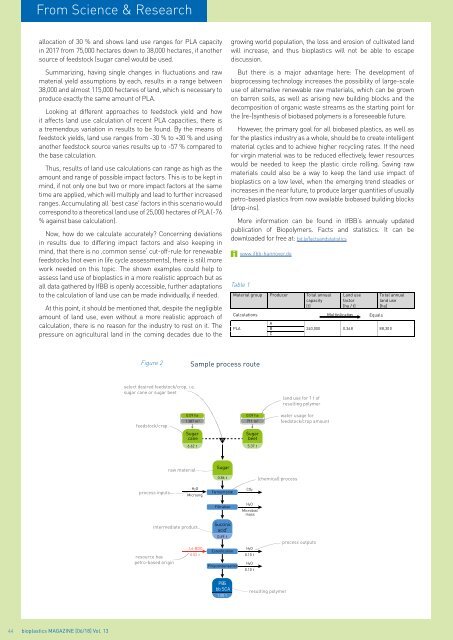Issue 06/2018
bioplasticsMAGAZINE_1806
bioplasticsMAGAZINE_1806
You also want an ePaper? Increase the reach of your titles
YUMPU automatically turns print PDFs into web optimized ePapers that Google loves.
From Science & Research<br />
allocation of 30 % and shows land use ranges for PLA capacity<br />
in 2017 from 75,000 hectares down to 38,000 hectares, if another<br />
source of feedstock (sugar cane) would be used.<br />
Summarizing, having single changes in fluctuations and raw<br />
material yield assumptions by each, results in a range between<br />
38,000 and almost 115,000 hectares of land, which is necessary to<br />
produce exactly the same amount of PLA.<br />
Looking at different approaches to feedstock yield and how<br />
it affects land use calculation of recent PLA capacities, there is<br />
a tremendous variation in results to be found. By the means of<br />
feedstock yields, land use ranges from -30 % to +30 % and using<br />
another feedstock source varies results up to -57 % compared to<br />
the base calculation.<br />
Thus, results of land use calculations can range as high as the<br />
amount and range of possible impact factors. This is to be kept in<br />
mind, if not only one but two or more impact factors at the same<br />
time are applied, which will multiply and lead to further increased<br />
ranges. Accumulating all ‘best case’ factors in this scenario would<br />
correspond to a theoretical land use of 25,000 hectares of PLA (-76<br />
% against base calculation).<br />
Now, how do we calculate accurately? Concerning deviations<br />
in results due to differing impact factors and also keeping in<br />
mind, that there is no ‚common sense‘ cut-off-rule for renewable<br />
feedstocks (not even in life cycle assessments), there is still more<br />
work needed on this topic. The shown examples could help to<br />
assess land use of bioplastics in a more realistic approach but as<br />
all data gathered by IfBB is openly accessible, further adaptations<br />
to the calculation of land use can be made individually, if needed.<br />
At this point, it should be mentioned that, despite the negligible<br />
amount of land use, even without a more realistic approach of<br />
calculation, there is no reason for the industry to rest on it. The<br />
pressure on agricultural land in the coming decades due to the<br />
growing world population, the loss and erosion of cultivated land<br />
will increase, and thus bioplastics will not be able to escape<br />
discussion.<br />
But there is a major advantage here: The development of<br />
bioprocessing technology increases the possibility of large-scale<br />
use of alternative renewable raw materials, which can be grown<br />
on barren soils, as well as arising new building blocks and the<br />
decomposition of organic waste streams as the starting point for<br />
the (re-)synthesis of biobased polymers is a foreseeable future.<br />
However, the primary goal for all biobased plastics, as well as<br />
for the plastics industry as a whole, should be to create intelligent<br />
material cycles and to achieve higher recycling rates. If the need<br />
for virgin material was to be reduced effectively, fewer resources<br />
would be needed to keep the plastic circle rolling. Saving raw<br />
materials could also be a way to keep the land use impact of<br />
bioplastics on a low level, when the emerging trend steadies or<br />
increases in the near future, to produce larger quantities of usually<br />
petro-based plastics from now available biobased building blocks<br />
(drop-ins).<br />
More information can be found in IfBB’s annualy updated<br />
publication of Biopolymers. Facts and statistics. It can be<br />
downloaded for free at: bit.ly/factsandstatistics<br />
www.ifbb-hannover.de<br />
Table 1<br />
Material group Producer To tal annual<br />
capacity<br />
[t]<br />
Calculations<br />
PLA<br />
A<br />
B<br />
C<br />
Land use<br />
factor<br />
[ha / t]<br />
Multiplication<br />
Equals<br />
To tal annual<br />
land use<br />
[ha]<br />
240,000 0.368 88,300<br />
Figure 2<br />
Sample process route<br />
select desired feedstock/crop, i.e.<br />
sugar cane or sugar beet<br />
land use for 1 t of<br />
resulting polymer<br />
feedstock/crop<br />
0.09 ha<br />
1 387 m³<br />
Sugar<br />
cane<br />
6.62 t<br />
or<br />
0.09 ha<br />
711 m³<br />
Sugar<br />
beet<br />
5.37 t<br />
water usage for<br />
feedstock/crop amount<br />
raw material<br />
Sugar<br />
0.86 t<br />
(chemical) process<br />
process inputs<br />
H2O<br />
Microorg.<br />
Fermentation<br />
CO2<br />
Filtration<br />
H2O<br />
Microbial<br />
mass<br />
intermediate product<br />
resource has<br />
petro-based origin<br />
1,4-BDO<br />
0.52 t<br />
Succinic<br />
acid *<br />
0.69 t<br />
Esterification<br />
Polycondensation<br />
H2O<br />
0.10 t<br />
H2O<br />
0.10 t<br />
process outputs<br />
PBS<br />
bb SCA<br />
1.00 t<br />
resulting polymer<br />
44 bioplastics MAGAZINE [<strong>06</strong>/18] Vol. 13


















